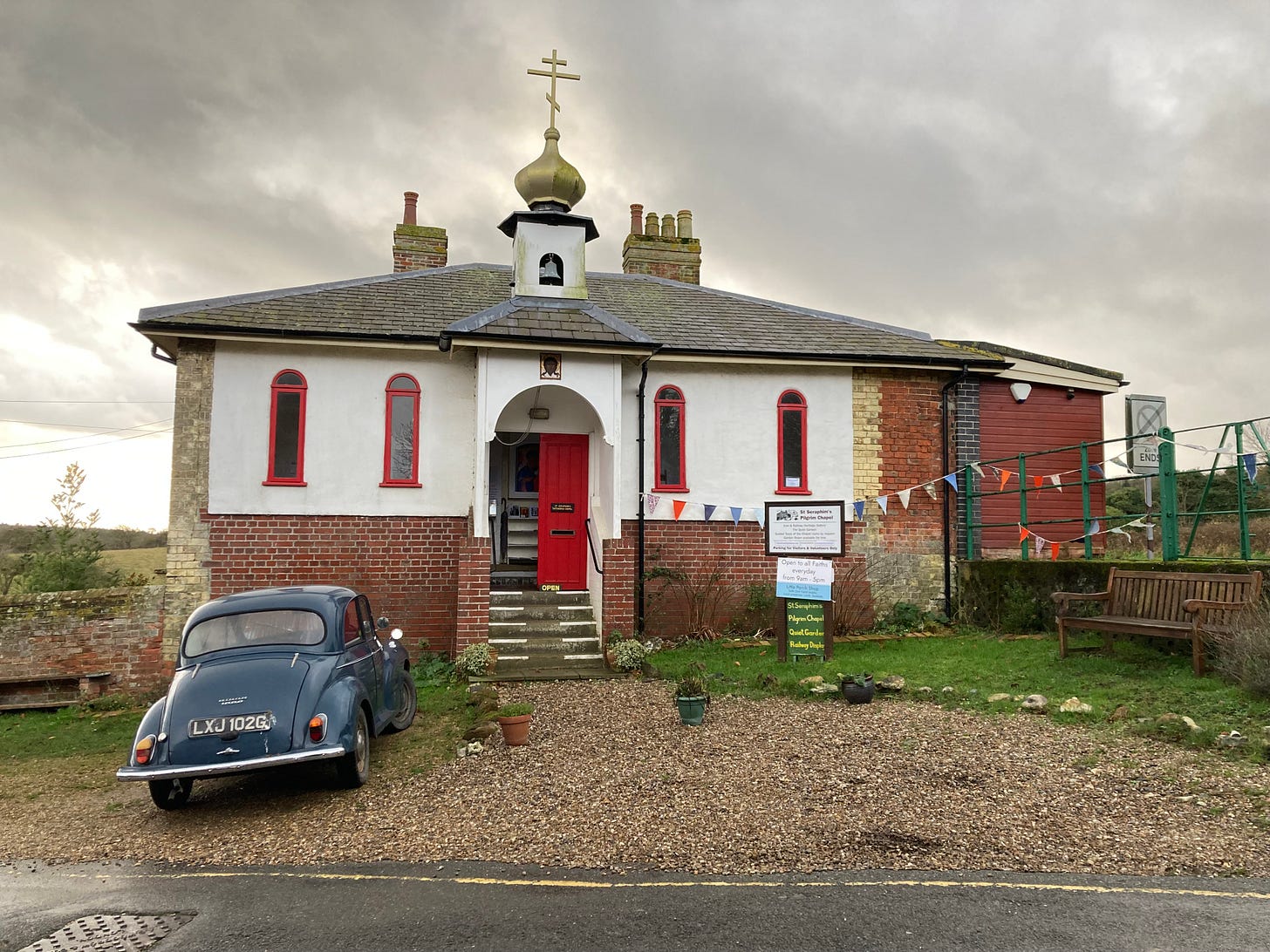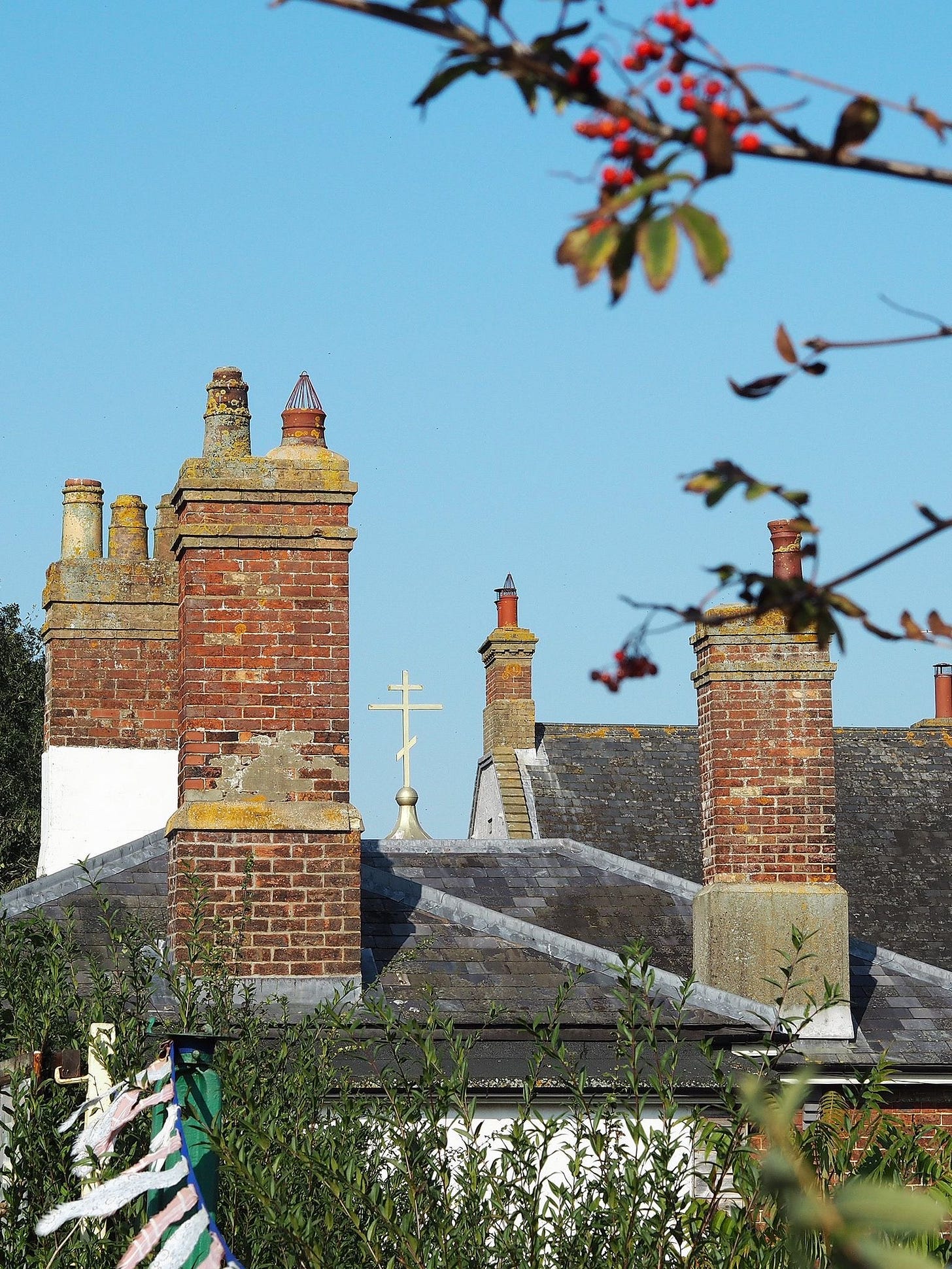In 1963 the infamous Beeching report recommended the axing of much of United Kingdom’s rail network. One of the many stretches doomed by that report was the Wells and Fakenham line that for a little over a hundred years served the pilgrimage centre of Walsingham in North Norfolk. Walsingham, known as ‘England’s Nazareth’, is the site of a vision of the Virgin Mary in Anglo-Saxon times. It has been a major pilgrim destination since that time notwithstanding a painful hiatus of several centuries occasioned by King Henry VIII’s nakedly avaricious dissolution of the monasteries. But just as the veneration of the Mother of God at Walsingham was eventually and miraculously revived, so also, on a much smaller scale, did its tiny station experience its own kind of rebirth – and in much shorter order. Uniquely, of all the many hundreds of railway stations that were shuttered by Dr Beeching, Walsingham’s station was reborn within a few short years as an Orthodox monastery, Church, and icon studio dedicated to one of the greatest Orthodox saints of the modern era, Saint Seraphim of Sarov (1754-1833).
The ever-memorable English Orthodox bishop and theologian, Metropolitan Kallistos of Diokleia (1934-2022) was a great lover of the railways, and had special affection for St Seraphim’s. He often said that if railway stations had to be closed down, and to him this was never a given, then the very best thing one could do with them is to turn them into Orthodox Churches. For him there was something intensely beautiful in a steam train, a mysterious quality in the railways somehow revelatory of what it means to be human. But there is, so far as I know, only one station closed in 1960s that was reborn as an Orthodox Church – only one Orthodox station.
Another great lover of the railways, and tireless campaigner against the Beeching cuts and the many wanton barbarisms of our time (such as the destruction of the Euston Arch), was the Poet Laureate Sir John Betjeman (1906-84). Betjeman, a High Church Anglican, was devoted to Walsingham and was much taken by the transformation of the old station, declaring in one piece of particularly fine prose: ‘Now is the Orient come to East Anglia’. In many ways he was spot-on in this observation. It is indeed wholly remarkable to find an old railway station in a remote corner of North Norfolk becoming a centre of the Eastern Orthodox Church whose heartlands lie a very long way East of East Anglia, quite amazing to find a Church in what had been a waiting-room and a golden onion dome with three bar cross atop an attractive but undistinguished brick building. But in another way he was wrong, or at least saw only part of the picture. It has long been the fate of the Orthodox Church in Western Christian circles to be either lavishly praised or bluntly dismissed but in both cases, whether regarded positively or negatively, the general tendency is to treat Orthodoxy as something foreign, something other, something essentially irrelevant to the central concerns and battles of the Christian West viewed as these are largely along a Protestant–Catholic axis. In some very important ways this establishment of a permanent Orthodox presence in Walsingham was not so much the advent of the mysterious orient amidst the muddy fields of rural England but rather a kind of homecoming.
One of the chief concerns of Archimandrite David Meyrick (1930-93), founder of St Seraphim’s in the late 1960s, was to live out a form of Orthodoxy rooted in this land. He and his small community celebrated their services chiefly in English (still quite a rarity at the time) and, even more importantly, set out to explore, venerate, and depict the saints of what the Romans called the alter orbis (‘another world’) of Britain and Ireland. Indeed St Seraphim’s became for some decades a great centre for the hymnography and iconography of the saints of these isles. It was here that many of the troparia and kontakia (Orthodox hymns) for the saints of Britain and Ireland were first composed, here that the icons of many of these saints were first painted. This is, in other words, a form of Orthodoxy very much at home in this corner of the Christian West. In the contemporary spiritual landscape, still scarred by the devastation of the Reformation and ravaged still further by the inroads of secularism, St Seraphim’s continues to have a vital role in enabling men and women of all stripes to connect with the spiritual patrimony of these sainted isles.
St Seraphim’s sits at the highest point of the village of Little Walsingham (about 100 feet above sea level – Norfolk is not a mountainous county). It looks down on a village which, almost uniquely in today’s England, is almost entirely geared around the Christian faith. There is a substantial Anglican and Catholic presence drawing thousands of pilgrims a year in common devotion to the Mother of God. There is even a Methodist Church. It is an expression of Orthodoxy, in other words, that is inherently bound up with ecumenical witness and co-operation.
And why I am here, and why am I writing about St Seraphim’s? My usual job is as Professor of Patristic and Byzantine Theology at Marquette University (Milwaukee, USA). But I am currently on sabbatical, writing a book on the theology of history, and am doing so in the peaceful confines of England’s Nazareth. My usual writing is academic and not particularly geared to this platform. Indeed I have to admit that I am no great fan of the internet in general but have been convinced from various quarters that it may be worth embracing it, at least for a brief period, in order to make St Seraphim’s and its work better known. I have known St Seraphim’s on and off since entering the Orthodox Church as a young student (thanks largely to the instruction and example of Metropolitan Kallistos and to a life-altering meeting with St Sophrony of Essex – but that’s a story of its own). My wife’s connection with the chapel goes back far longer and is far deeper: this is where her parents were received and married by Fr David, where she was baptised, and where her father was ordained deacon. It is she who has taken up the position of iconographer-in-residence and manager at St Seraphim’s during this period. She has many plans for our time here, some of which will no doubt find a way into this electronic publication. This publication is not, I should note, an ‘official’ publication of the St Seraphim’s Trust (who run and oversee St Seraphim’s) but simply an attempt to spread the news about this unique place as it enters a new phase.
These opening paragraphs will, I hope, have given some idea of the kind of themes you are likely to encounter in this occasional electronic publication from Walsingham: British (and Irish) saints, icons, pilgrimage, ecumenical endeavour and, perhaps occasionally, steam trains (a heritage line from Wells stops just a few hundred yards away).
Finally, a word on the title. From what I have written, ‘Orthodox Station’ should make sense: it does what it says on the tin (to quote a well-known advert from the UK). But it was also intended as a kind of homage to one of the greatest travel writers of the twentieth century, Robert Byron (1905-41) and his inimitable book on Mount Athos: The Station (London: 1931) – a exuberantly written book that is by turns hilarious (especially about the food), gently irreverent, full of wonder, and profoundly perceptive. Byron explains the slightly enigmatic title only in the last lines of the book when, on taking leave of the Holy Mountain, he looks back from sea at the triangular peak of Athos and marvels at its timeless quality, calling it a ‘station of faith where all the years have stopped’. Now Athos may be many things: a monastic republic with a history stretching for more than a millennium, a global centre of Orthodox asceticism, a beacon of noetic prayer, home to innumerable saints and elders, a place of staggering beauty. It is all these things, and more. But it has never had a railway station.
Next time: British Saints and the Orthodox today.






